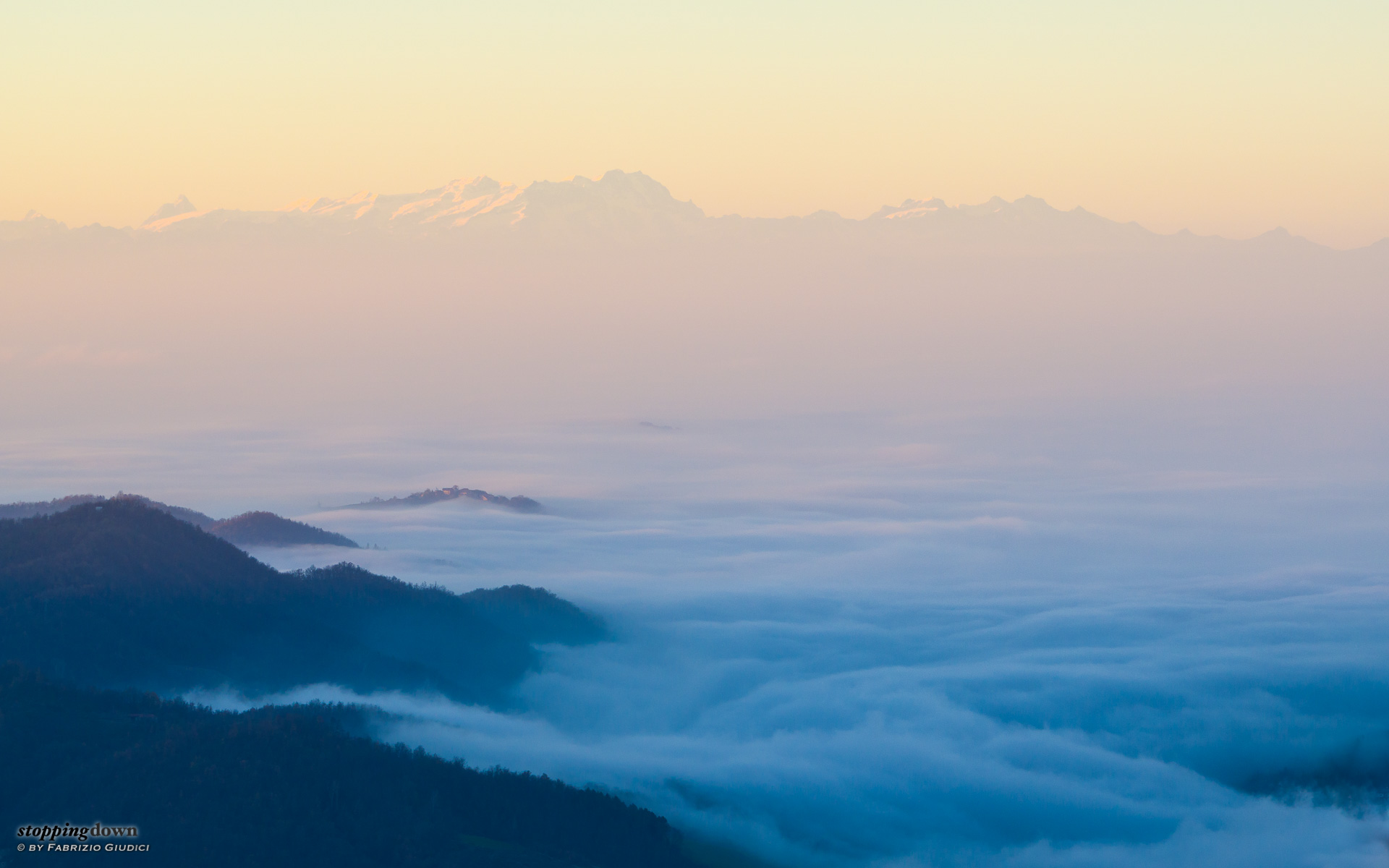Since a few years, October and November for me have been meaning “foggy landscapes in Bourgogne”. Almost every fall. Unfortunately, it wasn't the case for this year, in which I was actually unable to even go to France, if not by means of a few single-day excursions. Too bad.
What I really like in a foggy landscape is that “middle earth” of uncertainty where fog starts to be intermittent, appearing all of a sudden after a bend of the road and vanishing moments later, perhaps combining with the sun rays; often changing the quality of the light, turning it from cold to warm. So far, for me that has been the typical foggy landscape of Bourgogne: which also makes the thing more precious by means of many ancient castles and villages scattered here and there.
Sony α6000 + Sony FE 70-200mm F4 G OSS @ 125 mm, 1/200 sec @ ƒ/5.6, +0.70 EV, ISO 200, monopod.
Mare di nebbia con Monte Rosa e Cervino.
Seasonal fog can be found almost everywhere in Northern Italy; though not precisely in my home county, where it's a relatively rare phenomenon, but just at the other side of the Apennines. But, for what I can see, there's something different than in Bourgogne: probably the morphology of hills, whose height, there, stays more or less the same forever (unless you reach the plain of a large river), offering multiple “middle earth” perspectives. On the contrary, here hills steadily grow because they quickly transition into mountains, as the nearby Apennines have quite a few peaks over 1.500 metres; so all you have is a single abrupt change, with less chances of having a village or a castle in the right place. If the fogs of Bourgogne are like a lagoon with its many shoals, the fogs of Northern Italy — at least in the places closer to home — are more like an open sea surmounted by large cliffs; perhaps with a few islands near the coastline. I much prefer lagoons; but, in change, my country offers the vision of majestic peaks of the Alps emerging at the horizon.
Sony α6000 + Sony FE 70-200mm F4 G OSS @ 200 mm, 1/200 sec @ ƒ/8, +0.70 EV, ISO 200, monopod.
Panorama con Alpi Graie e mare di nebbia.
Sony α6000 + Sony FE 70-200mm F4 G OSS @ 200 mm, 1/125 sec @ ƒ/8, +1.30 EV, ISO 200, monopod.
Panorama con mare di nebbia e Gran Paradiso all'orizzonte.
In the past days, continuing the approach “take advantage of what you have nearby” that this year is at least mitigating my inability to travel, I've explored the mountains and the hills just after the Apennines, along the line Genoa-Milan, eventually making some detour along the road when I had a few hours available. This county is called “Oltregiogo genovese” (the former word roughly meaning “beyond the range of mountains”), as in ancient times it was parts of the fief (later the Republic) of Genoa; while, at a certain point after the establishment of the Kingdom of Italy, it was assigned to a different region.
Sony α6000 + Sony FE 70-200mm F4 G OSS @ 200 mm, 1/100 sec @ ƒ/8, +0.70 EV, ISO 100
E poi apparve il Monte Rosa...
Sony α6000 + Sony FE 70-200mm F4 G OSS @ 70 mm, 1/100 sec @ ƒ/8, +0.70 EV, ISO 100
Paesagio autunnale con Monte Rosa.
These days made it possible for me to do some further practice with post-processing and pastel colours, avoiding the temptation of artificially increasing the contrast and the saturation.
Sony α6000 + Sony FE 70-200mm F4 G OSS @ 119 mm, 1/8 sec @ ƒ/8, +2.30 EV, ISO 100, tripod.
Sale la nebbia sull'Oltrepò.
Sony α6000 + Sony FE 70-200mm F4 G OSS @ 166 mm, 1/10 sec @ ƒ/8, +2.30 EV, ISO 100, tripod.
Sale la nebbia sull'Oltrepò.
It was also a good manual focusing exercise: after the sunset, when the light had gone away and the contrast in the scene was low because of the coming fog, it was the only way to consistently get sharp images.















